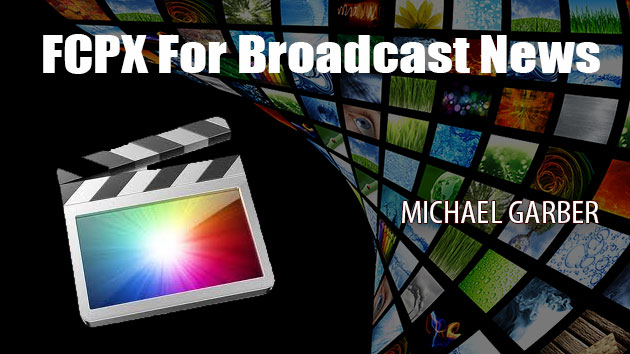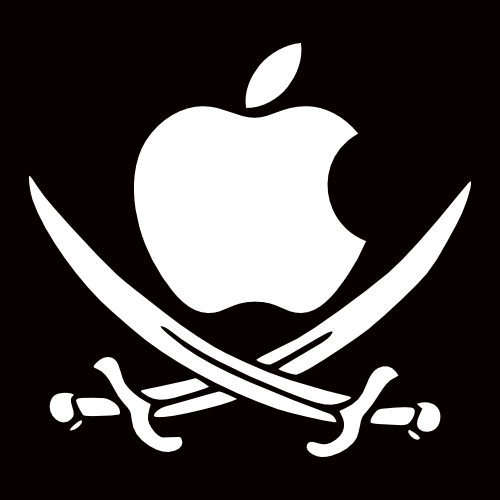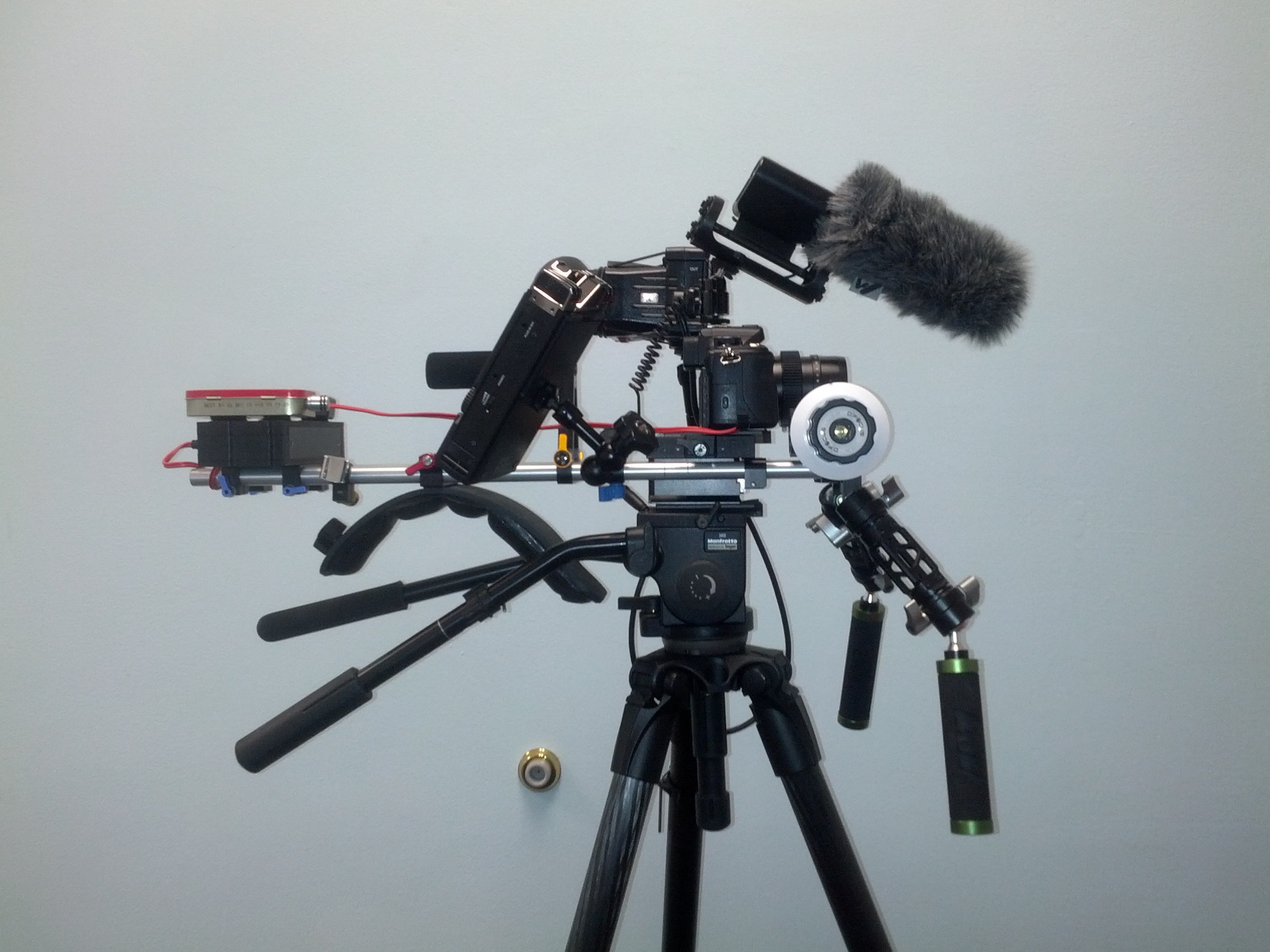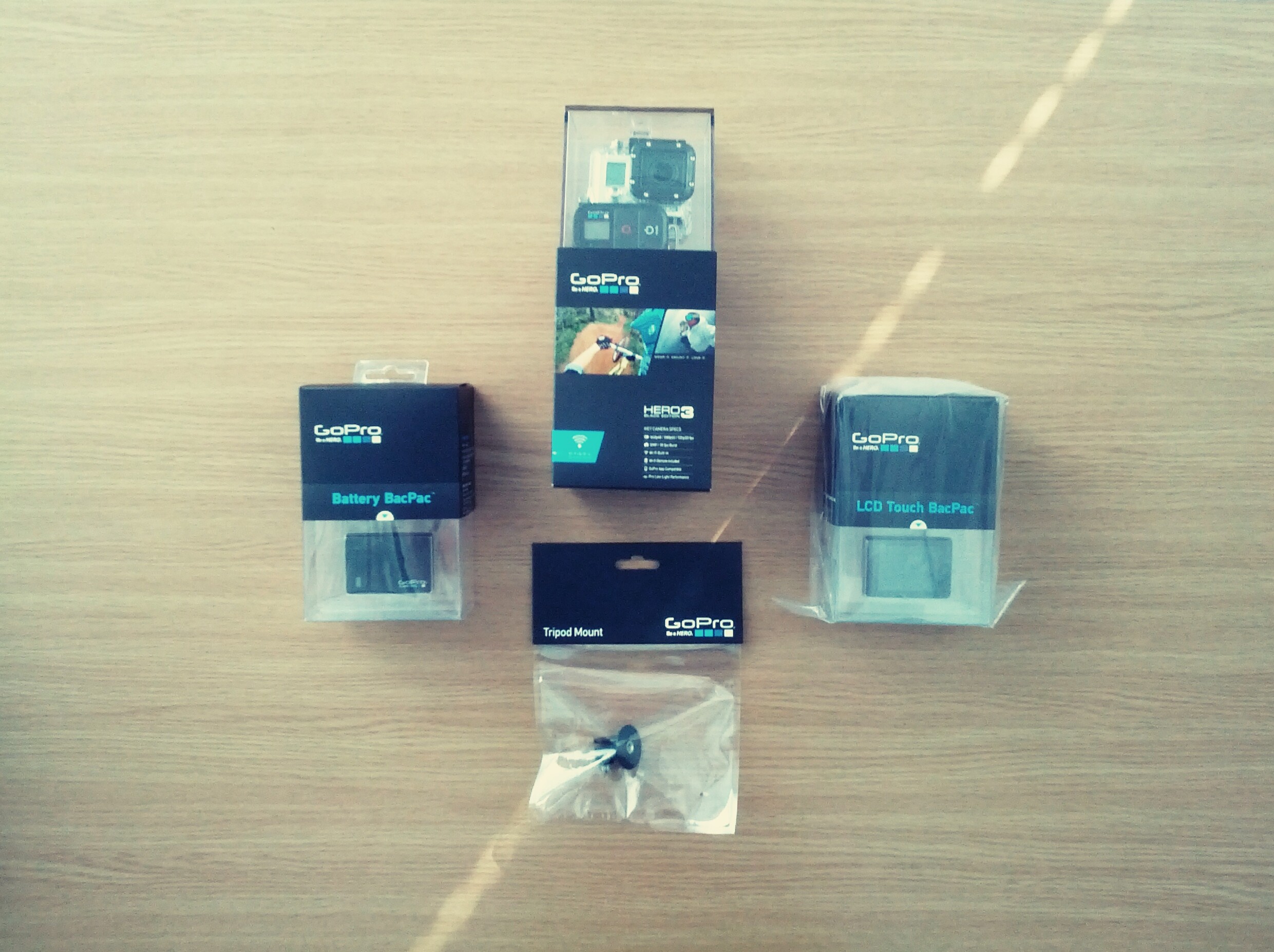Michael Horton of the LACPUG was kind enough to invite me to teach a webinar on my methods for cutting news and documentaries in FCPX. If you are interested in attending the webinar, you can sign up by clicking this link or the image below.
Over the past two years, I spent hundreds of hours intensely studying FCPX to see if I could use it to edit broadcast news stories that I had cut for years in FCP legacy. In recent months, I was finally able to put finger to keyboard and write a bit of a tutorial/manifesto/documentation about my experiences and techniques.
I hope you enjoy this article as much as I did writing it.
http://library.creativecow.net/garber_michael/FCPX-News-Editing/1

As I mentioned a couple weeks ago, I’m considering adding a small jib to my rig. There are lots of options out there, from cheaper carbon fiber ones to more expensive solutions that have a built in pan head.
Some have a way to tilt the camera, which I think is quite necessary. The ones that don’t tilt the camera are generally cheaper and very light. They are considered “travel jibs.” Those models also allow for the extension of the back end that allows for using less counter-weight.
Right now, it’s down to three options, all have positives and negatives. I’m looking for the best value – something that doesn’t cost an arm and a leg and will provide excellent results.
Has anyone had experience with these jibs? Any recommendations? Feel free to post your comments and recommendations below.

This is a re-post from a response I recently added to a Creative Cow thread about the value of Hackintoshes. I built one late last year and I’m happy with it. But I know that happiness comes with a cost. The system does not have a high resale value and has many potential troubleshooting issues down the line.
I came to terms with the reason why I wanted to build one: because I wanted to know IF I could build one. It was a challenge which was frustrating but fun. I love learning about all the tech we use in our daily lives. It was a satisfying DIY project.
I ultimately feel that buying Apple provides a better value over building a Hackintosh. But you don’t necessarily gain knowledge about your system and it’s components if you purchase a Mac. It’s like buying a refrigerator. If it breaks, you call a repair man. You’re most likely not going to open it up and fix the compressor (unless you’re a repair man!). So you might never understand how a refrigerator, a very important piece of tech in your life, works.
—–
Hackintosh part prices below are current and possibly not reflective of what I paid. But it’s very close. This gets you mostly in parity with a top of the line iMac (minus Bluetooth and WiFi, which cost about $46 total for the components). Here are my specs:
Intel Core i7-3770K $320
Gigabyte GA-Z77X-UP5-TH (has 2 thunderbolt ports) $245
32GB 1600Mhz DDR3 $217
Corsair Carbide 500R $158
Corsair 650 Watt Modular $90
GeForce GTX 680 $497
480GB SSD Drive $363
Syba SATA III 6Gbps PCI-e Card $17
StarTech.com 3 Port 2b 1a 1394 PCI Express FireWire Card Adapter PEX1394B3 $63
Cooler Master Hyper 212 EVO: $33
I owned a Kona 3, which I installed and is working fine.
TOTAL: $2003
iMac System Specs:
3.4GHz Quad-Core Intel Core i7
8GB 1600MHz DDR3 SDRAM-2X4GB
1TB Fusion Drive
NVIDIAGeFrc GTX 680MX 2G GDDR5: $2600
AppleCare: $170
RAM from OWC: $270
TOTAL: $3040 (before tax)
Now, here’s the kicker. While Geekbench isn’t the be-all end-all, I think it’s a nice cross-reference for the technologically-barely-informed (such as myself ;-)).
My iMac 27″ top o’ the line gets a healthy 14268
The Hack Pro gets a substantial 14124
For all intents and purposes, they are equal systems. One costs $3014 and comes with a warranty. The other costs $2003, works great, and is expandable, but has risks. Again, if you need to purchase a monitor, keyboard and mouse for the Hackintosh, that will add an additional amount and bring them much more in line price-wise.
Let’s look at the percentage difference if we take out AppleCare to get the systems more in line.
iMac: 2845
Hack Pro: 2003
Percent Difference: %30
Now, let’s look at potential resale value and upgrade costs. This is assuming a new iMac will cost about the same amount in 2 years:
iMac late 2012 resale value in 2 years (conservative): $1250
iMac 2014 (high end) potential cost: $ 2900
Out of pocket difference: -$1650
Time needed to reinstall software and test new system: 1 day (based on purchase of iMac)
Hackintosh upgrade option 1, resale and build from scratch:
Hackintosh Late 2012 Cost: $2003
Hackintosh Resale Value in 2 years: $400
Hackintosh Late 2014 potential cost: $2000
Out of pocket difference: -$1600
Time needed to research new system and find best prices on parts: countless nights on Hackintosh boards
Time spent building system: 1 day
Time spent testing parts and debugging: 2 days (conservative)
Hackintosh upgrade option 2, upgrade CPU, Mobo, and RAM
New Motherboard, Processor, RAM (assuming all current PCI Cards work properly and base prices stay the same): $782
Time spent researching whether all parts will work with new system and what CPU/Mobo to get: 2-3 evenings on hack boards
Time spent installing new parts: 2 hrs
Time spent reinstalling OS, debugging: 1 day (conservative)
So there you have it. At most, there’s an $870 difference (not including time spent) in favor of an equally spec’d Hack Pro and a top-end iMac over a 2-year period. Divide that out by 2 years and that’s $37 per month.
The ultimate question I propose (which I’ve already answered for myself): Is it worth it for you to build one?
Here at “Production Central” as I’m now starting to call my company, I am getting excited about completing the current stage of my kit. I’ve come to understand that the kit is never finished. Newer, better equipment is always coming out. There’s a great market on Craigslist for used gear. So, once you buy in, your upgrade costs are much lower than the price of admission.
First off, I’m looking to get a jib. I’ve been doing tons of research and I’m currently eyeing this guy, the Kessler Pocket Jib Traveler.

It looks like a brilliant design and a great price. I’m hoping there will be some reviews soon. I could see traveling with this even on some upcoming overseas news shoots!
Next up is a new slider. I’ve been toying with the idea of getting either a Kessler Stealth Slider or the Philip Bloom Edition Slider. There’s also the Edelkrone SliderPlus. They all look amazing, but the prices on these are just too high.
So this led me to eye the Varavon Lite 800 along with a Motorroid. Specifically, the OliviaTECH edition,which is currently on pre-sale for $580 with shipping.
http://youtu.be/RvuGxtlq8LE
Personal-View.com is having a Varavon special today (3/18) only for a total of $540.
It’s an investment that will increase the production value of my shoots. I am currently pitching jobs to a couple of larger companies and institutions. This gear will go a long way to making their videos look great.
This is something I’m very excited about. Redrock Micro has announced the availability of it’s new shoulder pad and rig accessories.
I had the opportunity to try new shoulder pad out at Redrock’s booth at DV Expo in Pasadena a few months ago. I was initially very impressed.
Admittedly, I am a bit obsessed with my straight DSLR rig. There’s no one way and no perfect way to mount all the items you need to shoot for a day when using a DSLR camera.

One of the biggest problems I have encountered in mounting all these items to rails is the sheer weight. If you put 7 or 8 lbs in front of you, then you need to counter it with the appropriate amount of weight behind you. My rig comes in at about 15 lbs. That’s a lot heavier than the weight of a teeny tiny camera!
Basically, what many of us shooters are trying to do when building a rig is to replicate the ENG camera shooting experience while capturing that amazing cinematic DSLR look. Aaaand we are also trying to save a buck or two in the process.
I have tried 3 different shoulder pads. The two main issues I’ve had with these pads are that they cause shoulder pain and they lack the ability to reposition the camera horizontally. They don’t mold to the shape of your shoulder. So, it’s hard to get comfortable and even harder to get a level picture. I end up contorting my body to try to get a level image and at the end of the day, my back and body are tweaked.
I also like the idea behind Redrock’s microBalance Plus Cheeseplate because of the ability to slide the cheeseplate and counterweight left and right. Having lots of arm accessories on the left and right of the rig causes strange balance issues. My Roland R26 with XLR cables is mounted on the right and can cause the rig to lean to the right. My hope is that this will balance the rig so that it sits flat on my shoulder when combined with the new shoulder pad.
I have been shooting more news and docu-style these days. So, I’m looking to perfecting that all-in-one ENG camera experience, while maintaining the power of DSLR shooting. I’m going to test the Redrock Micro shoulder pad soon and will let you all know what my findings are.
 I’m impatiently waiting to open these boxes. Got this GoPro Hero 3 Black Edition and accessories from the local Best Buy by sheer luck. They just happened to get a shipment in and I just happened to be there!
I’m impatiently waiting to open these boxes. Got this GoPro Hero 3 Black Edition and accessories from the local Best Buy by sheer luck. They just happened to get a shipment in and I just happened to be there!
The reason I’m holding off opening them is because I am waiting to find out if I’ll be going overseas for a news shoot next month. I plan on using the GoPro as a B-Cam for additional b-roll and interviews. Really curious to see how the scaling will look. In addition, I got a Steadicam Smoothee, for moving shots.
Will all these wonderful toys get opened? Or sold on the open Craigslist market if I don’t get a the job to cover the cost? Tune in for details! Should know in the next week or so. Hoping the fun begins soon!
One of my favorite blog sites is Lifehacker. Every now and then they have an article titled “My name is x and this is how I work.” They interview tech folk, business folk, creative folk, and more.
Since I might never be interviewed for this on Lifehacker (well, one can dream!), I decided to get the ball rolling and put it on phosphor. So, this is how I work:
Name: Michael Garber
Occupation: Owner, Editor, Producer, 5th Wall; Blogger, Garbershop
Location: Los Angeles, CA
Current computers: 2 very old Mac Pros. 1 2008 Mac Pro. 1 Macbook Pro. 1 White iMac. 1 Completely Awesome Hackintosh.
Current mobile device: Samsung Galaxy Nexus
I work: Whenever I’m sitting down and sometimes when I’m standing up.
Final Cut Pro (all flavors and varieties). Premiere. Photoshop. Chrome. Google Apps for Business (mobile and desktop). Google Docs/Drive. All things Google, really. Dropbox. Quicktime 7… I hope it never goes away.
Gmail labels, archiving, and stars. Before Gmail, so much of my day was spent sifting through email. As soon as I moved over to Gmail (not an easy move, mind you) and I wrapped my head around using tags rather than folders, everything changed. I now operate a near-zero inbox. Messages don’t stay in there for more than a day. It’s usually the most important oh-my-god-it-needs-to-be-done-right-now messages that stay in my inbox. Things that I’m working on or need to be referred to quickly get a star.
Google Tasks. I know there might be better/more feature rich ones out there. But it’s simple, syncs with my phone and I can pull the list up any time through a widget. For certain lists, such as for office supplies or groceries, I find handwritten is always better. It’s too time consuming to keep turning on the phone so you can add a check mark.
My Wacom Intuos tablet. That’s what kept me from getting carpal tunnel. And it also made me 50 times faster during an edit session. I have a small Bamboo tablet that I bring with me to locations for editing. But I love the large Intuos the most.
At the moment, my workspace is the kitchen table. On some days it’s my “old edit bay.” And others it could be one of my edit suites. I consider myself very lucky to be able to leave one for another.
My “old edit bay” is really my center of operations. It’s fairly simple for an edit bay and very homey. I have a desk with two short equipment racks underneath, a tall restaurant style metro shelving rack for gear, drives, and more. As I mentioned above, there is a large Intuos 3 Wacom tablet that I use with all of my Mac Pros. I have a 16-channel mixer and two old JVC speakers that I’ve had since my first edit system in 2000.
In some bays I have two monitors which I use to separate out all my programs. Chrome goes on the right monitor. FCP lives on both. Other apps usually reside on the left monitor.
Back in the meat world, I have a couch behind me that is old, now, but is really the most comfortable damned couch in the world. I also have a large filing cabinet.
I try to keep paperwork to a minimum, but there is a certain amount of paperwork that is necessary to run any type of corporation or business. So that is where my important docs reside.
I also try to stay organized. But ultimately, I’ll keep one pile on the left side of my desk. That’s the equivalent to my Google Star folder. But in all honesty, I probably go through those papers less often than I go through my star folder.
I uploaded all my music to Google Music about a year ago. So glad I did. There’s a lot of music that I’ve never listened to in my own library. What I listen to can be really random.
I love movie scores. So if I want to feel most like myself and get into a groove, I’ll put something of that variety on. I’ve always considered myself a pretty musical person, but I’m not necessarily into music. I never remember band names or songs. I don’t hear the words in songs and rarely remember them. I always hear rhythm and the main tune.
I generally go to bed between midnight and 1. If work is light, I tend to stay up until 3. It’s not very productive since I generally wake up tired.
Editing in FCP legacy. I am so fast editing in that wonderfully conceived timeline.
It’s not what you know, it’s who you know. My father would say that just about every day when I was starting to figure out what my career path would be.
I’m not sure if I have any readers or fans, yet. So, to anyone who stumbles across this, I think that the most important thing isn’t that you follow any one method for working a specific way. Rather, it’s important that you spend time in your life figuring out what works for you. What can you do to help yourself work at your best? And then, implement it! When things stop working, try to take a step back and figure out what went wrong and then adapt.
[fve]http://www.vimeo.com/53381762[/fve]
A little backstory about myself and delis… In 1994, I attended New York University’s Tisch School of the Arts. I was a film student. While I cherish my time at NYU more than anything, the truth is this: I really went to the school of “New York City.”
What an amazing time it was to be living in NYC in the mid-to-late 90’s. Coming from Jacksonville, Florida, it was like going from a world that was one color to a universe of infinite variations. The city was filled with so much noise, people, potholes, personality and, most importantly, the most amazing food I had ever eaten up until that point in my life. And by the best food, I mean deli food. Jewish deli.
I come from a conservative Jewish family. I went to a conservative Jewish synagogue. But, I’m from Northern Florida and there’s a slightly different flavor between Northern Florida Jewery and that of the Northeast US and, to the far south, Miami.
While there was one major deli in my home town that had been around since my grandparents’ time, it wasn’t a place my family ever went to that often. In fact, I can’t remember a time that we went there as a family. We just agreed that it wasn’t very good.
Over the years, there was a flashier “New York-style” deli that opened up in Jacksonville. It was plastered with lots of mid-to-late-1980s Broadway glitz and glam. It had the obligatory A Chorus Line and Cats posters, the shiny black tiled walls and some gold lettering. It even had the signed headshots, too. It was more I Heart NY than I heart Pastrami. My father loved that place until the food and the service started to suffer. Once that happened, it failed. Now, a Mexican restaurant stands in its place, serving gooey helpings of cheesy burritos with gobs of spanish rice. It’s been there at least 3 times as long as the original deli.
Once in college, it took me over a year to feel really comfortable with setting out into the city. And it wasn’t until my sophomore year that I finally went to the 2nd Ave Deli. This changed everything. It was like I finally found the place I had always been looking for.
Let me put it this way – if you were a Jewish kid from a faraway place, who grew up hearing Broadway musicals from the 40’s and 50’s and watched PBS documentaries on the great Jewish comedians of early television… if you were a Jewish kid who dreamed of being in a world of really interesting people who were loud, obnoxious, brilliant, and hilarious… if you were a Jewish kid who heard tales of the amazing food that your parents and grandparents ate growing up but those places no longer existed because of a lack of interest and also because of the low-fat diet craze… if you were a Jewish kid just looking for a place to fit in and feel Jewish in the real world rather than in an insular community of your peers… well, this was Jewish Mecca. I guess that would technically be Jerusalem. But you get the point.
I loved that place. I ate there as regularly as I could afford the food. And I made a short video piece about it after it’s owner, Abe Lebewohl, was tragically murdered.
When I graduated from film school, I was looking for a project. One potential was a documentary about Jewish deli. It would be called “The Great Deli Debate” and it would focus on the rivalry between east coast and west coast delis. But at that time, it was too expensive to shoot it on film and video just didn’t have the cinematic quality that I wanted for the piece.
I moved on, got settled in LA. Found Langers pastrami. Got interviewed by my client, Huell Howser, on an episode of his series which happened to focus on tongue sandwiches. And then, I was happy. I felt that I had done my duty to deli.
If Judaism had a flavor and a scent, I think most east coast Jews would agree that it tastes and smells like the food you get at a good Jewish Deli. I hope the filmmaker gets lots of funding with this appetizing trailer and makes a great documentary that can help the institution of Jewish deli survive. No debate there!